CPU Scaling of Graphics Cards
In order to find out the dependency of various GPUs on fast CPUs, we took our Athlon 64 test bed and while keeping all variables the same, adjusted the clock speed from 1GHz all the way up to 2.6GHz. We ran two groups of cards across the entire spectrum of clock speeds in order to get CPU scaling curves on a per card basis.
The first group of cards were classified as "High End" cards and were all run at 1600 x 1200. All of the cards are graphed on the same graph as to help users determine at what CPU speed it makes sense to purchase a faster card.
The second group of cards were classified as "Mid Range" cards and were all run at 1280 x 1024. All of the cards are graphed on the same graph as to help users determine at what CPU speed it makes sense to purchase a faster card.
By no means were these charts meant to be all inclusive, but they should serve as a good guide for weighing CPU vs. GPU purchases. We also included a benchmark of Half Life 2 deathmatch in the results here using our own custom demo - at_mp_3.
All cards were run at the same high detail settings we performed our Half Life 2 GPU comparison under.
High End Graphics Card CPU Scaling
For our High End cards we’re looking at the Radeon X850 XT Platinum Edition, the Radeon X800 XT and Radeon X800 Pro from ATI. From NVIDIA we have the GeForce 6800 Ultra and GeForce 6800GT. We realize that this isn’t an all encompassing list of GPUs, but you should be able to extrapolate scaling of similar high end cards based on their performance relative to these five.
The most important graph is the first one as it is an average of all six of our Half Life 2 timedemos and gives you the best overall indication of CPU scaling of these GPUs on a holistic level. We have, however, included the individual charts for each timedemo for reference.
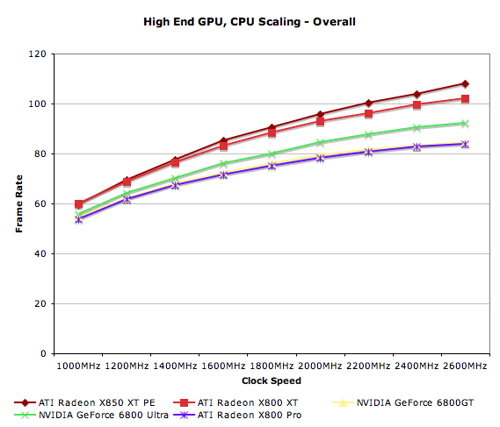
Interestingly enough, at 1600 x 1200, all of these high end GPUs scale quite similarly with CPU speed. We see that at lower speeds, the X850 XT PE performs identically to the X800 XT, it is only after you get above 2.2GHz on the Athlon 64 that the two even begin to separate. The same is not true for the GeForce 6800GT and Ultra, those two really begin separating much earlier on in the game.
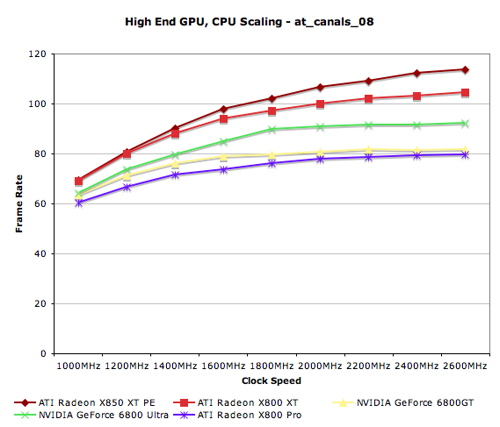
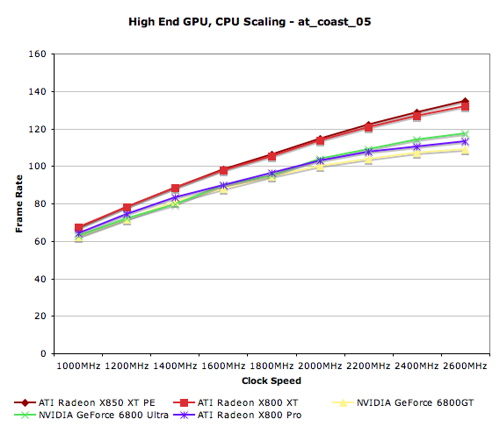
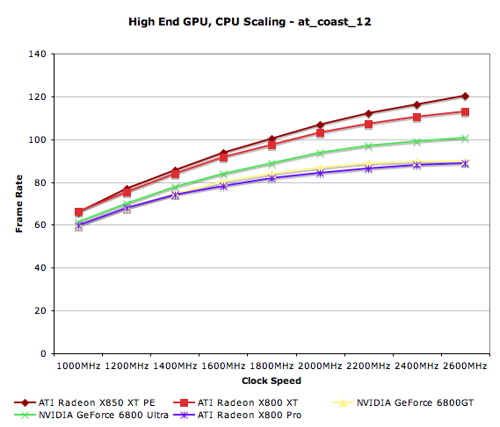
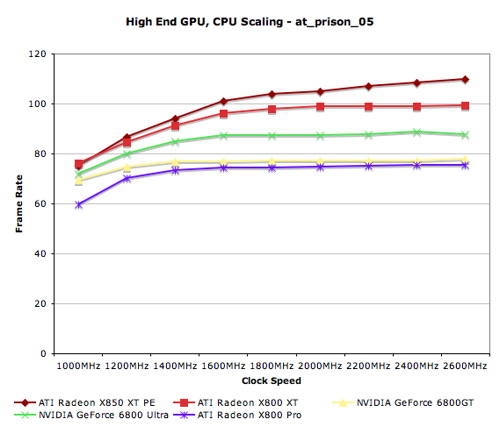
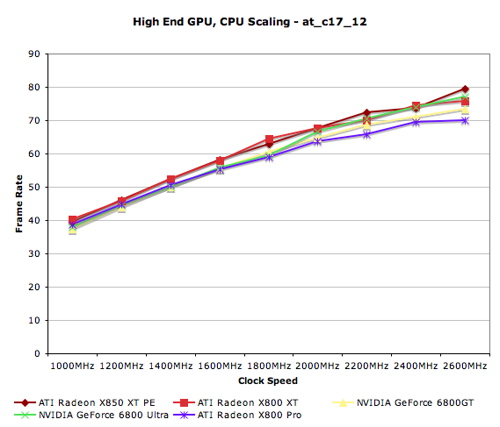











68 Comments
View All Comments
zhangping0233 - Thursday, January 5, 2012 - link
Nice job, If you need any flashlight, pls contact Xecconlight.com feel free.PrinceGaz - Friday, January 28, 2005 - link
by the way, you can't mod a 9500Pro to a 9700Pro, the 9500Pro circuit-board only has a 128-bit memory-bus and there's no way you can change it to 256-bit.PrinceGaz - Friday, January 28, 2005 - link
#55- the cut-off point where you can't really tell the difference of a higher framerate, is when the framerate exceeds the monitor refresh rate.If your monitor is updating the display 85 times per second (a common setting for cheaper CRT displays), then a *minimum* framerate of higher than 85fps makes no difference. With flat-panels, refresh-rates of 60-75hz are more common so you don't even need to maintain 85fps. A faster graphics-card is still worthwhile though as it allows you to crank up AA and Aniso settings (8x anti-aliasing is lovely).
maestroH - Friday, January 28, 2005 - link
Coming from the recent dark age of a P4 1.7/9500Pro(@9700Pro) combi, this is great article to decide on my new machine. Although HL2 is playing quite nicely, I am lucky to have a one-off opportunity to buy myself a FX-55/X800XT combi.Never having experienced even any fps close to what's on these charts, something in the back of my mind keeps saying that a 10-20 fps more when you are already over 100 fps, will make no difference to the experience except a bigger hole in my wallet. Can anyone tell me where the 'cut-off' point is where even the most discerning of gamers cannot see/feel the difference? Knowing that dual core is coming up (even though games for them still need to be made), would buying a 3500+ be smarter or should I go for the FX-55 simply because I can (only this once)? Thx Anand for the article.
essjae - Thursday, January 27, 2005 - link
Those graphs look nice, but they don't really mean much. Based on similar graphs and results I just bought a a64-4000+ and MSI Neo2 Platinum to replace my P4-3.2GHz and Asus P4c-800E.With the same ATI X800XT Platinum, memory, and hard drives, I can't see any difference between then, in fact, the P4 seemed to play smoother.
Do I have any proof, no, other than playing half-life 2 on my p4 was more enjoyable.
Spacecomber - Thursday, January 27, 2005 - link
Can anyone offer some insight into why the extreme edition northwoods did as poorly as they did? The 3.2GHz EE could barely keep up with the 3.0GHz Prescott; so, it's more than the raw clock speed of the high end Prescotts.Could it be related to running the Northwood on a platform really intended for Prescotts?
Space
mixpix - Thursday, January 27, 2005 - link
Awesome article. It was exactly what I've been looking for. My 2600+ is not cutting it with my 6600GT AGP and I was thinking it was the CPU that was limiting preformance.TheCanuck - Thursday, January 27, 2005 - link
Firing Squad did a review on the Athlon XP performance with HL2 a while ago:http://www.firingsquad.com/hardware/half-life_2_at...
The 3200+ XP got about 95fps in the Canals_09 demo at 1280x1024 with an X800 XT PE. Not sure how well it compares to the Canals_08 that Anandtech uses, but I doubt the difference would be that great.
Guspaz - Thursday, January 27, 2005 - link
I'm very dissapointed with this article. I have been eagerly awaiting it for ages, expecting to see how Half-Life 2 scales down to lower speed processors; I've long maintained that low end processors like an AthlonXP 1900+, run the game quite poorly.The big deal with HL2 is that it was supposed to run on much older computers. But nobody seems to have benchmarked it on anything but pretty new hardware. I expected that a CPU scaling article would cover that, in fact I thought that was the entire point.
Visual - Thursday, January 27, 2005 - link
i'd be curious to see normal 6600, as well as maybe some lower-end ati card in the comparison :)ok ok, i know this isn't a GPU shootout, but still...